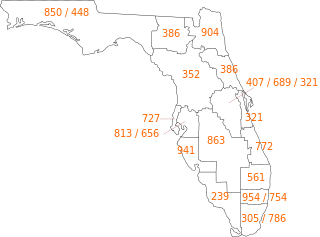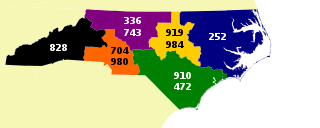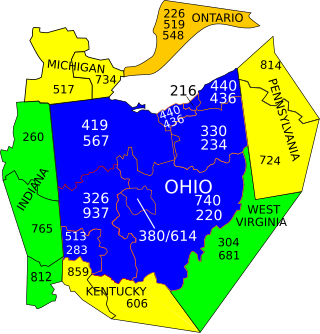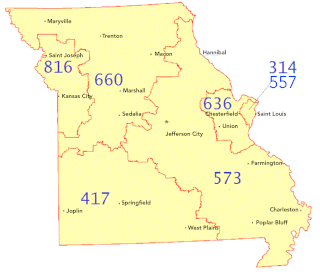
The North American Numbering Plan (NANP) is a telephone numbering plan for twenty-five regions in twenty countries, primarily in North America and the Caribbean. This group is historically known as World Zone 1 and has the telephone country code 1. Some North American countries, most notably Mexico, do not participate with the NANP.

Area codes 314 and 557 are telephone area codes in the North American Numbering Plan (NANP) in the U.S. state of Missouri, serving the city of St. Louis and most of its inner-ring suburbs in neighboring St. Louis County. The numbering plan area is bordered to the west by area code 636, which serves St. Louis' outer suburbs to the west, south, and north. Across the Mississippi River to the east, 314 is adjacent to area code 618, which serves southern Illinois and most of Metro East. Area code 557 was added to the 314 numbering plan area on August 12, 2022, to form an overlay numbering plan.
Ten-digit dialing is a telephone dialing procedure in the countries and territories that are members of the North American Numbering Plan (NANP). It is the practice of including the area code of a telephone number when dialing to initiate a telephone call. When necessary, the ten-digit number may be prefixed with the trunk code 1, which is referred to as 1+10-digit dialing or national format.
Seven-digit dialing is a telephone dialing procedure customary in some territories of the North American Numbering Plan (NANP) for dialing telephone numbers in the same numbering plan area (NPA). NANP telephone numbers consist of ten digits, of which the leading three are the area code. In seven-digit dialing it is not necessary to dial the area code. The procedure is also sometimes known as local format or network format.

Area codes 561 and 728 are telephone area codes in the North American Numbering Plan (NANP) for Palm Beach County in the U.S. state of Florida. 561 was created on May 13, 1996, in a split of area code 407. The numbering plan area (NPA) comprises nearly every major city in the county, the largest of which being West Palm Beach, Boca Raton, Wellington, Boynton Beach, Jupiter, Delray Beach, and Belle Glade. On March 10, 2023, area code 728 was added to the same numbering plan area to form an all-services distributed overlay.

Area codes 920 and 274 are telephone area codes in the North American Numbering Plan (NANP) for a large area of eastern Wisconsin. Area code 920 was created on July 26, 1997, in a split of area code 414, one of the original North American area codes of 1947. 274 was added to the same numbering plan area (NPA) on May 5, 2023 to create an area code overlay.

Area code 564 is a telephone overlay area code in the North American Numbering Plan (NANP) for Western Washington state, including metropolitan Seattle. The area code was first proposed in 1999 to relieve telephone number shortages in area code 360, but implementation was delayed until 2017, when it was installed for an overlay complex that comprises only the numbering plan area 360. Neighboring area codes 206, 253, and 425 were slated for expansion of the overlay upon exhaustion of central office codes in each NPA. In 2023, area code 206 was approved for expansion with a guide line for preparation of inclusion of at least nine months. Ten-digit dialing has been mandatory in all of western Washington since July 29, 2017.

Area codes 516 and 363 are telephone overlay area codes in the North American Numbering Plan (NANP) for the U.S. state of New York. The numbering plan area (NPA) comprises Nassau County on Long Island. Area code 516 was created in 1951 and 363 was added to the numbering plan area in 2023.

Area codes 202 and 771 are telephone area codes in the North American Numbering Plan (NANP) for Washington, D.C.
Area code 246 is the telephone area code in the North American Numbering Plan (NANP) for Barbados. The sequence 246 spells BIM on an alpha-numeric telephone keypad, a nickname for the island.
Area codes 876 and 658 are telephone area codes in the North American Numbering Plan (NANP) for Jamaica.

Area codes 910 and 472 are telephone area codes in the North American Numbering Plan (NANP) for southeastern North Carolina. The area codes form an overlay for a numbering plan area (NPA) that includes the cities of Wilmington, Jacksonville, Laurinburg, Lumberton and Fayetteville. Area code 910 was established in 1993, and 472 was added to the same area in October 2022.

Area codes 678, 470, and 943 are telephone area codes in the North American Numbering Plan (NANP) for the U.S. State of Georgia in the Atlanta metropolitan area. The area codes are assigned in an overlay plan to a combined numbering plan area (NPA) consisting of 404 and 770.

Area codes 408 and 669 are telephone area codes in the North American Numbering Plan (NANP) in the U.S. state of California. The numbering plan area comprises most of Santa Clara County and Northern Santa Cruz County, and includes Gilroy, Morgan Hill, Saratoga, Los Gatos, Monte Sereno, Milpitas, Sunnyvale, Santa Clara, Cupertino, Campbell, and San Jose.

Area codes 410, 443, and 667 are telephone area codes in the North American Numbering Plan (NANP) for the eastern half of the U.S. state of Maryland. The numbering plan area (NPA) includes the Baltimore metropolitan area and the Eastern Shore. The three area codes are overlay codes for one numbering plan area, among which 410 was the initial area code for the NPA, when it was split from area code 301 in 1991. 443 and 667 found assignment primarily in cellular service and for competitive local exchange carriers, such as Comcast and Cavalier Telephone, when introduced, but have since become universal in carrier availability.

Area codes 513 and 283 are telephone area codes in the North American Numbering Plan (NANP) for the southwest of the U.S. state of Ohio, including Cincinnati and surrounding cities, such as Forest Park, Hamilton, Lebanon, West Chester, Mason, Maineville, Middletown, Milford, Norwood, Oxford, Harrison, Cleves, Miamitown and Trenton.

Area codes 816 and 975 are telephone area codes in the North American Numbering Plan (NANP) for most of the Missouri side of the Kansas City metropolitan area, the St. Joseph area, and all or part of 15 surrounding counties in northwestern Missouri. The numbering plan area originally comprised most of the northern and western two-thirds of the state, bordering with Arkansas, Illinois, Iowa, Kansas, Nebraska, and Oklahoma, but has been reduced to a ribbon bordering Kansas. 816 is one of the original 86 area codes created in 1947. The numbering plan area was converted to an overlay complex with area code 975 in 2023.

Area codes 270 and 364 are telephone overlay area codes in the North American Numbering Plan (NANP) for the Commonwealth of Kentucky's western and south central counties. Area code 270 was assigned in a split of numbering plan area 502 in 1999. Area code 364 was added to the same numbering plan area in 2014, after having been first considered for 270-relief planning in 2007. Major cities in the numbering plan area include Hopkinsville, Paducah, Henderson, Murray, Bowling Green, Owensboro, Elizabethtown, and Madisonville. It also includes Kentucky's share of Fort Campbell.

Area code 864 is a telephone area code in the North American Numbering Plan (NANP) for the western third of the U.S. state of South Carolina. The numbering plan area (NPA) comprises the areas of Greenville, Spartanburg, Anderson, and twelve surrounding counties. Other cities in the 864 territory include Clemson, Gaffney, Greer, and Mauldin. It is largely coextensive with the Upstate region.

Area codes 503 and 971 are telephone area codes in the North American Numbering Plan (NANP) for the northwestern region of the U.S. state of Oregon. The numbering plan area (NPA) comprises the cities of Portland, Salem, and Astoria. Area code 503 was one of the original North American area codes of 1947, assigned to the entire state until 1995, when its extent was reduced to the northwestern corner. Area code 971 was assigned to the service area in stages, completed in 2008, to form an overlay in the area with ten-digit dialing.















